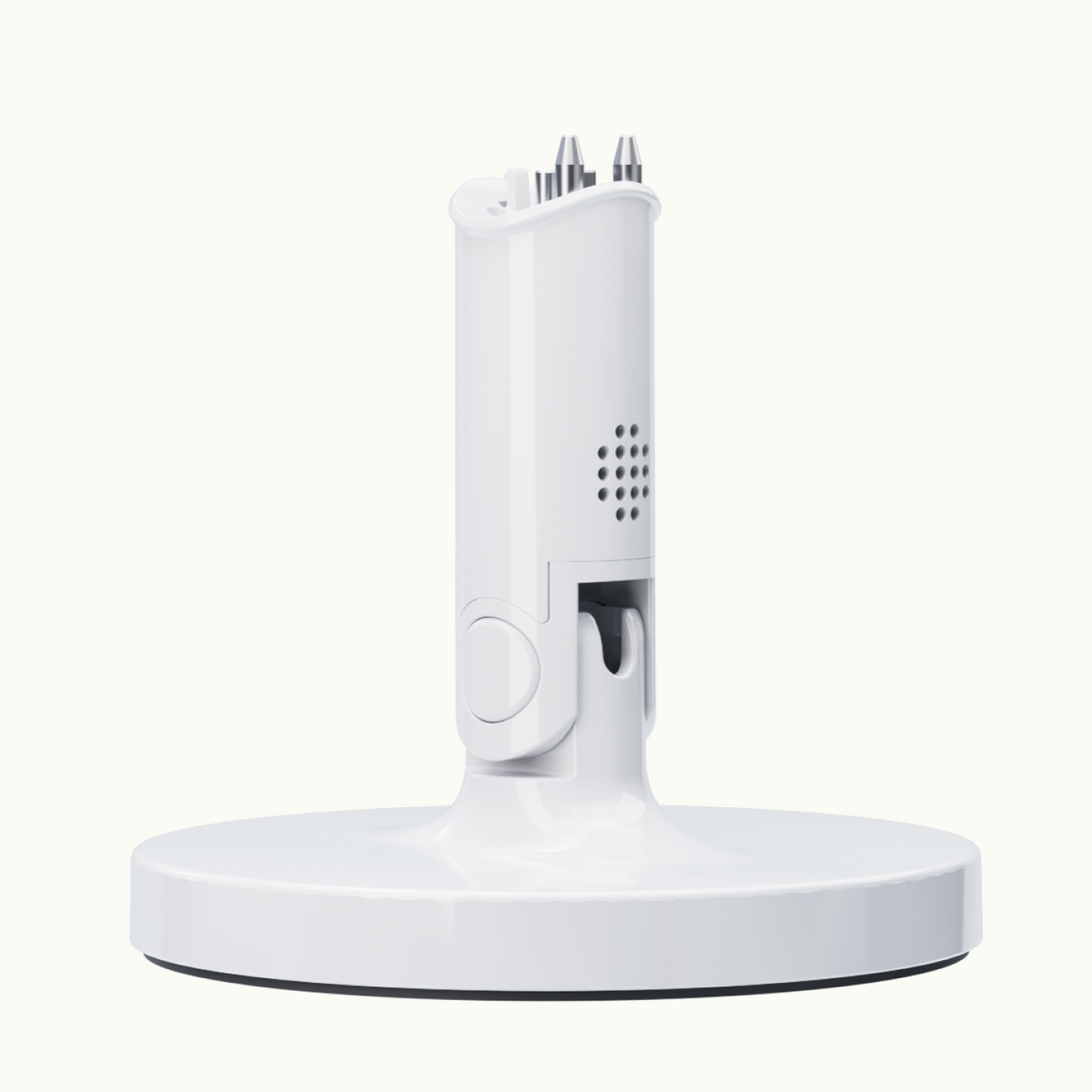You tried to put your baby to bed at 7 p.m., but now it’s 9 p.m. and they’re still screeching and sobbing, refusing to go down. You know they need sleep, so why won’t they? Read on to discover why babies fight sleep and how you can help soothe an overtired baby.
Why do babies fight sleep?
After putting your little one down to sleep roughly an hour ago, you still hear them babbling to themselves or crying, trying to fight off the sleep. What’s keeping them up? Here are some common reasons why your little one might be fighting sleep.
- They’re not sleepy. If your baby is fighting sleep, the reason why could be as simple as they’re not tired. Maybe their nap was a little long or too late in the day, or they’re entering a new development phase that affects their sleeping patterns. Timing your baby’s sleep so that they are tired (but not overtired!) when being placed in the crib is crucial.
- They’re overtired. Exhausted adults and babies don’t behave the same way. Once your baby becomes overtired, their stress responses kick into high gear. The hormones cortisol, which controls stress, and adrenaline, which triggers the fight-or-flight response, increase and take over. This results in the overtired meltdown every parent has witnessed at some point.
- They’re overstimulated. From a TV show to light-up noisy toys to a fun playtime, overstimulation can make it difficult for your little one to calm down before sleeping. Instead, shape a wind-down routine around reading books and soft music, which can calm them down and put your baby in the mindset for sleep.
- They’re experiencing separation anxiety. If you notice that your little one clings to you quite a bit, they could be experiencing separation anxiety. This reaction is completely normal for babies aged 6 months to 18 months, as they learn that you leaving the room is not a permanent state of affairs. Refusing to go to sleep if you’re not there can be a sign of separation anxiety.
- They’re hitting a milestone. Practicing rolling over, babbling, or sitting up are all milestones your little one might like to practice at night. Depending on their age, there’s a chance your child isn’t sleeping because they’re making their way to a new developmental stage.
- They’re not feeling well. It can be difficult for anyone feeling under the weather to fall asleep, babies included. Ear infections, colds, and coughing are all quite common for babies, so if they’re fighting sleep and the other reasons don’t seem to fit, they could be sick.
How do I get my baby to stop fighting sleep?
Once you figure out the “why” behind your little one’s defiant fight against sleep, you can work to help them get a good night’s rest. But even with that information in hand, there are some best practices to follow to ensure as many fulfilling nights of rest as possible.
Be patient with your child’s sleep challenges
Easier said than done! As much as you’d like your peace and quiet, you shouldn’t show your frustrations to your little one as they struggle to sleep. Babies can feel your frustration, so if they see you're upset, it might work them up more. Instead, come to them with patience and a soothing calmness that can help them feel at ease (and hopefully, the Zs come shortly after).
Learn their sleep cues
Do you know your baby’s sleep cues? Signs of eye rubbing, yawning, crying, or losing interest in their toys are all signs that your little one is ready for bed. Once you see these behaviors, it’s time to start their bedtime routine.
Create a calming bedtime ritual
Getting your baby in the mindset for sleep involves environmental clues and cues, such as bathtime, reading bedtime stories, or cozying up together in a glider for snuggles. Try the exclusive Routine Ready Bundle, a Nanit x Lalo x Ella Olla collaboration to ensure that your little one is clean, cozy, and calm for bath and bedtime. Whichever activities resonate most with you and your baby, try to keep them consistent each night and start roughly at the same time for best results.

Establish day and night behaviors
During the day, keep your baby active and alert between naps with toys, activities, and outdoor time, among other stimuli. Once nighttime rolls around, they’re hopefully tired enough to go right to sleep.
Eliminate rough play, loud noises, and screens
If you want your baby to sleep during their usual bedtime, take a cue from what adults are told all the time: Stay away from screens and overstimulating activities in the 30 minutes before bedtime. Make sure any part of your baby’s bedtime routine is cut from the same cloth.
Ensure you’re feeding your child enough
To help see if your baby is getting enough food, record when you feed them each day and how much they eat. If they’re not eating readily or easily, you may want to contact your pediatrician to make sure nothing else is out of the ordinary.
Make sure baby’s space is properly set up for sleep
Having a peaceful environment for your little one can greatly impact how well they sleep. To improve their sleep, hang some blackout curtains in their room and turn on a white noise machine (try Nanit’s Sound and Light, which can help establish healthy sleep routines).

How to spot the signs of an overtired baby
Thankfully, going to sleep isn’t a guessing game for parents. Your child will show some obvious signs that they’re ready for bed. Here are some common signals to look for so you know when it’s time to put your little one to bed.
- Yawning
- Eye rubbing
- Clinginess
- Whimpering
- Loss of interest in activities
- Crying
- Difficult to soothe
- Lower pain or frustration threshold
- Sleeping or napping at the wrong times
- Overactive
- Clumsiness (toddlers)
- Lack of coordination (toddlers)
How to help an overtired baby sleep
Your little one isn’t sleeping—but you sure wish you were. Here’s how to help soothe your child so you both can get some much-needed rest.
-
Swaddle them. Swaddling your baby can calm them down, as it replicates their environment inside the womb. It can also protect your little one from their startle reflex (also called the moro reflex), which can keep babies asleep for longer. The Nanit Breathing Wear Swaddle also helps parents monitor baby’s breathing motion while they rest, giving added peace of mind.
- Try sound. Certain quiet sounds can help calm your baby and help them drift off to dreamland. A white noise machine, soothing music, or your voice can all play a part.
-
Offer a gentle touch. Hold your baby close to your chest so they can hear your heartbeat. The physical touch and sound will help soothe your baby and make them feel protected.
- Try a pacifier. Pacifiers help babies feel content. Try a pacifier at bedtime to help your baby stay calm as they go to sleep. Just remember: You’ll have to wean them off it at some point in the future!
- Use gentle movement. Rocking your baby or putting them into a stroller can help them drift off to sleep. But sudden or fast movements can have the opposite effect, so move gently once they doze off.
- Reduce light in their room. Any bright light will leave your baby feeling alert and ready to take on the day. Instead, reduce as much light as you can in your little one’s nursery. Blackout curtains and low lighting from a nightlight can help.
How to prevent a baby from becoming overtired?
While you can’t always prevent your baby from becoming overtired, there are a few ways to try to keep them from getting there. Knowing their sleep cues in the first and most important step, whether your baby tends to yawn, rub their eyes, or lose interest in playing as bedtime approaches.
Another way you can help your baby get into a good sleeping routine is to create a day and nighttime schedule—and stick with it. Try putting your little one down at roughly the same (age-appropriate) time every day for naps and every night for sleep. Keep track of when they sleep and how long they sleep each time so you can adjust their schedule appropriately.
The bottom line
Sleep is crucial for your little one to grow and for you to function well during the day. And when you can’t beg your baby to go to sleep, you’ll have to try other tactics to calm them down. Being patient and calm can help an overtired baby unwind and get into the right mindset to doze off for the evening. Learning your baby’s cues, understanding why they might be awake, and how you can calm them down are great stepping stones to helping you both achieve blissful sleep.






